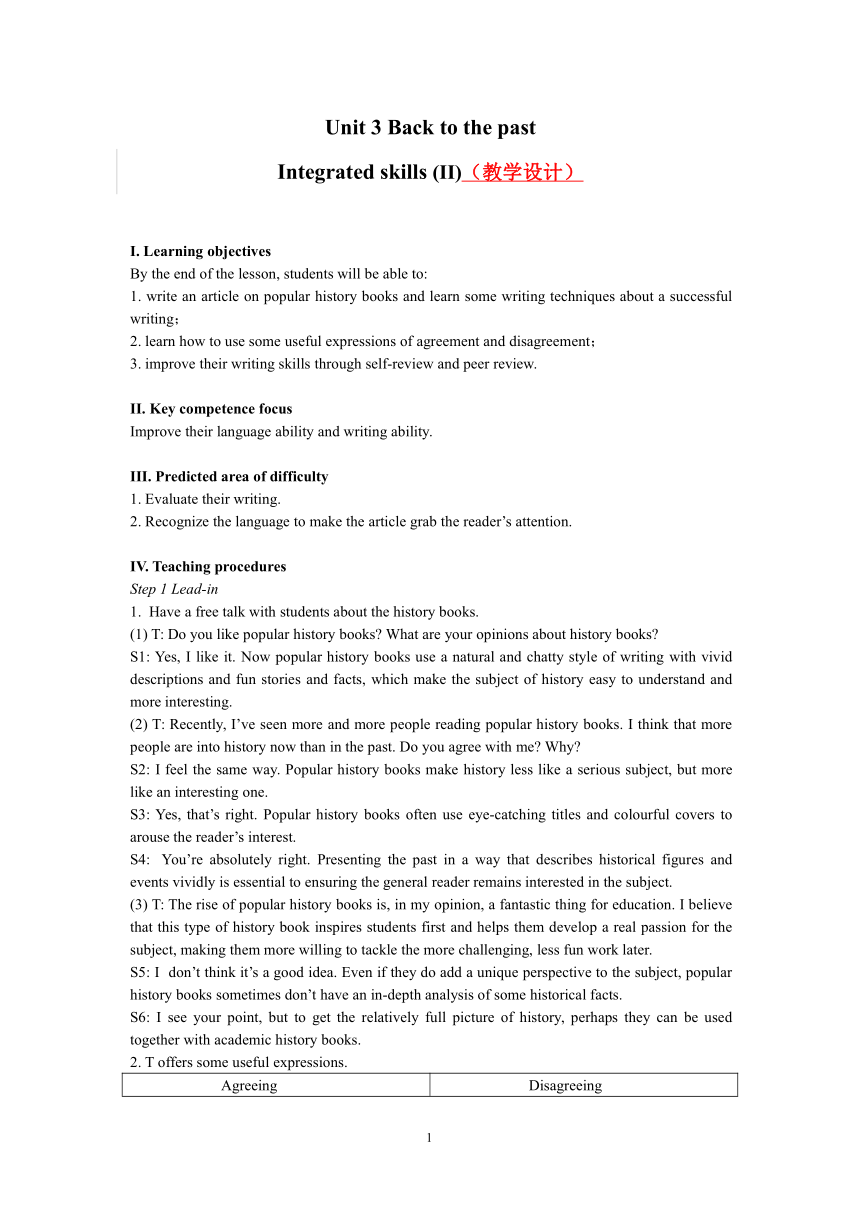
Unit 3 Back to the past Integrated skills (II)(教学设计) I. Learning objectives By the end of the lesson, students will be able to: 1. write an article on popular history books and learn some writing techniques about a successful writing; 2. learn how to use some useful expressions of agreement and disagreement; 3. improve their writing skills through self-review and peer review. II. Key competence focus Improve their language ability and writing ability. III. Predicted area of difficulty 1. Evaluate their writing. 2. Recognize the language to make the article grab the reader’s attention. IV. Teaching procedures Step 1 Lead-in Have a free talk with students about the history books. (1) T: Do you like popular history books What are your opinions about history books S1: Yes, I like it. Now popular history books use a natural and chatty style of writing with vivid descriptions and fun stories and facts, which make the subject of history easy to understand and more interesting. (2) T: Recently, I’ve seen more and more people reading popular history books. I think that more people are into history now than in the past. Do you agree with me Why S2: I feel the same way. Popular history books make history less like a serious subject, but more like an interesting one. S3: Yes, that’s right. Popular history books often use eye-catching titles and colourful covers to arouse the reader’s interest. S4: You’re absolutely right. Presenting the past in a way that describes historical figures and events vividly is essential to ensuring the general reader remains interested in the subject. (3) T: The rise of popular history books is, in my opinion, a fantastic thing for education. I believe that this type of history book inspires students first and helps them develop a real passion for the subject, making them more willing to tackle the more challenging, less fun work later. S5: I don’t think it’s a good idea. Even if they do add a unique perspective to the subject, popular history books sometimes don’t have an in-depth analysis of some historical facts. S6: I see your point, but to get the relatively full picture of history, perhaps they can be used together with academic history books. 2. T offers some useful expressions. Agreeing Disagreeing I am for you. I couldn’t agree more. I agree with you. Yes, that’s right. Yes, you are absolutely right. I feel the same way. I think so. I don’t have any objection to it. To be honest, I don’t agree with you. That’s not always the case. I don’t think that’s a good idea. I don’t see eye to eye with you. I’m sorry, but I totally disagree with you. I see your point, but ... I don’t think that’s true. 3. T offers some different opinions. For Against 1. make history less like a serious subject; 2. use eye-catching titles and colourful covers; 3. describes historical figures and events vividly; 4. inspire students and help them develop a real passion for the subject; 5. … 1. don’t have an in-depth analys ... ...
~~ 您好,已阅读到文档的结尾了 ~~

